Pool Maintenance and Cleaning: Fix Cloudy Water, Remove Algae, Chemicals
Maintaining your pool might seem overwhelming at first, but it’s pretty straightforward when you break it down. Whether you’re new to pool care or just looking for a refresher, keeping the water clean and balanced doesn’t have to be hard.
From managing chemicals to skimming out debris, I’ll walk you through what you need to know without the fuss. It’s all about sticking to a routine and catching small problems before they turn into big ones.
Tools and Materials
When it comes to maintaining your pool, having the right tools and materials is half the battle. With a few essentials at hand, you’ll be able to handle everything from routine cleaning to balancing water chemistry.
Tools You’ll Need
- Pool Skimmer: To remove leaves, bugs, and surface debris, ensuring your pool stays clear.
- Pool Vacuum: Essential for cleaning the bottom of the pool, especially areas your filter can’t reach.
- Pool Brush: Ideal for scrubbing walls, steps, and corners where algae and dirt like to build up.
- Water Testing Kit: A must-have for monitoring your pool’s chemical levels and keeping everything in balance.
Essential Materials
- Pool Chemicals: Chlorine, algaecide, and pH adjusters are vital for keeping your water clean and safe.
- Pool Shock: Used periodically to give your pool a deeper clean, especially after heavy use.
- Filter Cleaner: To maintain your filter’s efficiency and ensure proper water circulation.
When equipped with these tools, maintaining your pool becomes a manageable task. Like they say—an ounce of prevention is worth a pound of cure.
Basics Care: How to Clean a Swimming Pool?
Cleaning involves several steps to ensure it remains clean, hygienic, and safe. Here’s a guide you can see our experience with the process:
1. Skimming and Brushing:
- Skim the surface of the pool to remove leaves and other debris.
- Brush the walls and floor to dislodge algae and prevent staining.
2. Vacuuming:
- Use a pool vacuum to clean the bottom of the pool. This can be done manually or with an automatic pool cleaner.
3. Cleaning the Filter:
- Regularly clean the pool filter to ensure it’s trapping debris effectively. The method will depend on the type of filter you have.
4. Checking and Balancing Water Chemistry:
- Test the water for pH, chlorine, and other chemical levels and adjust as necessary to maintain proper balance.
5. Shocking the Pool:
- Periodically ‘shock’ the pool by adding a large dose of chlorine to kill any lingering bacteria or algae.
You may also like our guide Swim Year-Round with Diy Solar Pool Heater.
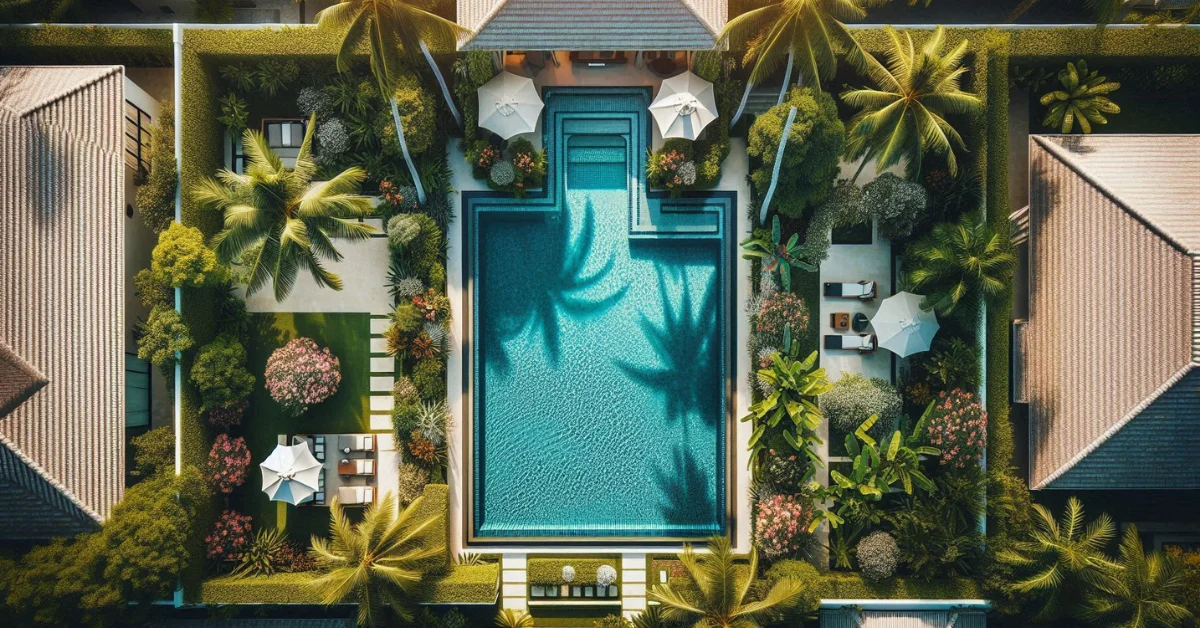
Weekly Pool Maintenance Checklist
A weekly maintenance routine is important to keep a pool in top shape. This ensures your water stays clean, chemicals remain balanced, and you prevent small issues from turning into bigger headaches down the road.
Essential Tasks
- Skim the pool surface for debris: Remove leaves, bugs, and dirt before they settle at the bottom, keeping the water clear and preventing clogging in your filter.
- Brush the walls and floor: Scrub down the pool’s surfaces to avoid algae buildup and stubborn dirt that can impact water quality.
- Vacuum the pool: Whether you use a manual or automatic vacuum, this step ensures a deep clean by removing the debris that settles at the bottom.
Quick Cleaning Tips for Busy Pool Owners
If time is short, consider using robotic vacuums to save you hours of manual labor. These vacuums automatically move through the pool, picking up debris while allowing you to focus on other tasks. With the right tools, you’ll be able to maintain a sparkling pool without the hassle, even on your busiest days.
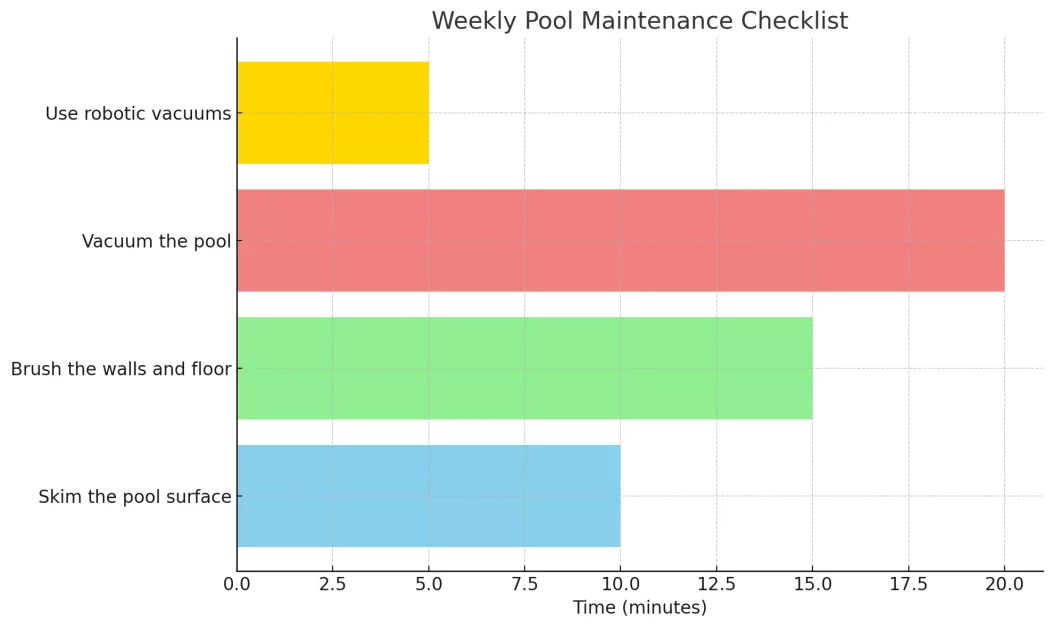
Pool Circulation: Why It’s Important
Proper circulation is crucial to maintaining clean, safe, and balanced pool water. Without it, you risk stagnant water, which can lead to algae growth, uneven chemical distribution, and filter inefficiency. Ensuring your pool’s water moves constantly through the system is one of the key ways to keep it in pristine condition.
Run the Pool Pump Daily
Running your pool pump for several hours each day is essential to keep the water circulating. This allows the water to pass through the filtration system, removing dirt, debris, and any impurities that accumulate.
- Why Circulation Is Key: Regular circulation prevents the water from becoming stagnant, which can lead to algae blooms and other contaminants settling in the pool. Moving water also helps distribute chemicals evenly, ensuring the entire pool stays sanitized.
Backwash or Clean the Filter
Your pool’s filter is the heart of the circulation system, trapping dirt and debris that the pump pushes through. Over time, filters can become clogged and less efficient, which is why regular cleaning is a must.
- Types of Filters: There are three main types of filters:
- Sand Filters: Use sand to filter out debris and require backwashing.
- DE (Diatomaceous Earth) Filters: Provide finer filtration but also need backwashing.
- Cartridge Filters: Require manual cleaning by removing and hosing down the cartridge.
- How to Backwash a Filter Step-by-Step
- Turn off the pool pump.
- Set the filter valve to “backwash” mode.
- Turn the pump back on and let it run until the water in the sight glass is clear (usually a few minutes).
- Turn the pump off again, reset the valve to “filter,” and restart the pump.
Clean the Skimmer Basket Weekly
Your skimmer basket collects larger debris, such as leaves and bugs, before they reach the filter. Cleaning this out every week ensures that the pool water can continue circulating smoothly without obstruction.
Optimize Water Flow by Angling the Jets
To maximize circulation, you can adjust the pool’s return jets to point slightly downward and at an angle. This promotes better water movement, ensuring that the bottom of the pool receives as much circulation as the top. By doing this, you’ll help the chemicals and filtration system work more efficiently.
What common mistakes should I avoid when cleaning my pool?
Common Mistakes to Avoid:
- Not testing water regularly: To keep chemical levels in check, it’s essential to test your pool water at least once a week.
- Ignoring pH levels: Your pool’s pH level affects the chlorine’s effectiveness. It should be maintained between 7.2 and 7.8.
- Forgetting to brush: While vacuuming is important, brushing the walls and floor is necessary to prevent algae and remove dirt that the vacuum might miss.
- Overlooking the filter: A dirty filter can’t trap debris, so clean it according to the manufacturer’s instructions.
- Adding chemicals during the day: Sunlight can reduce the effectiveness of chlorine. Add chemicals in the evening or at night when the sun is down.
Best Tools for Pool Cleaning
What are the essential tools needed for pool cleaning?
- Telescoping Pole: A versatile tool that can be fitted with skimmers, brushes, and vacuum heads.
- Pool Brush: Necessary for scrubbing the pool walls and floor to prevent algae buildup.
- Skimmer Net: For removing leaves and other floating debris from the water’s surface.
- Pool Vacuum: To clean the bottom of the pool; can be manual or automatic.
- Automatic Pool Cleaner: A device that automates the cleaning process, covering the pool’s surfaces.
How do I choose the right pool-cleaning tools?
- Consider the size and type of your pool when selecting tools.
- Look for durability and ease of use in the products.
- Manual tools are more affordable but require more effort.
- Automatic cleaners are more expensive but offer convenience and efficiency.
Can you recommend some top-rated pool cleaning tools?
- Robotic Cleaners: Such as the Dolphin Nautilus CC Plus, are known for their thorough cleaning and ease of use.
- Suction-Side Cleaners: Like the Zodiac G3, which are cost-effective and easy to maintain.
- Pressure-Side Cleaners: The Polaris Vac-Sweep models are famous for their powerful cleaning capabilities. For more information about why pool cover pumps are essential for pool maintenance,
Pool Water Chemistry: Keeping It Balanced
It’s important to keep your pool’s water balanced to maintain clear, clean water and prevent damage to the pool.
By keeping an eye on your pool’s chemical levels, you can avoid bigger problems down the line and enjoy a clean, safe swimming pool. Balanced water keeps swimmers safe and avoids common issues like algae and cloudy water.
Test Your Water Regularly
Testing your pool water twice a week helps you stay on top of important levels like chlorine, pH, alkalinity, and calcium hardness. By checking these regularly, you’ll be able to correct any problems quickly.
Chlorine and Sanitizers
Chlorine works to kill bacteria and prevent algae. The right level for your pool is 1-3 ppm (parts per million). Too little chlorine and the water can become cloudy or unsafe; too much and it might irritate the skin.
Balancing pH Levels
The pH level controls how acidic or basic your water is. Keep it between 7.2 and 7.6. If the water is too acidic, it can cause damage to the pool surfaces and irritate swimmers. If it’s too basic, the water might turn cloudy.
Managing Alkalinity and Calcium Hardness
Alkalinity keeps the pH level steady. You should aim for 80-120 ppm. Calcium hardness, on the other hand, should be between 200-400 ppm. If it’s too low, pool surfaces can get damaged. If it’s too high, it can lead to scale buildup.
Shocking the Pool
“Shocking” the pool means adding a high dose of chlorine to clean out any buildup that regular levels can’t handle. Doing this once a week or after heavy use helps keep the water crystal clear.
Pool Maintenance Cheat Sheet
- Y-Axis (Vertical): Lists the different pool maintenance tasks such as Skim, Brush, Vacuum, Test pH, and so on.
- X-Axis (Horizontal): Shows the frequency per month, ranging from 0 to 4. Each bar corresponds to how many times the task should be done in a month.
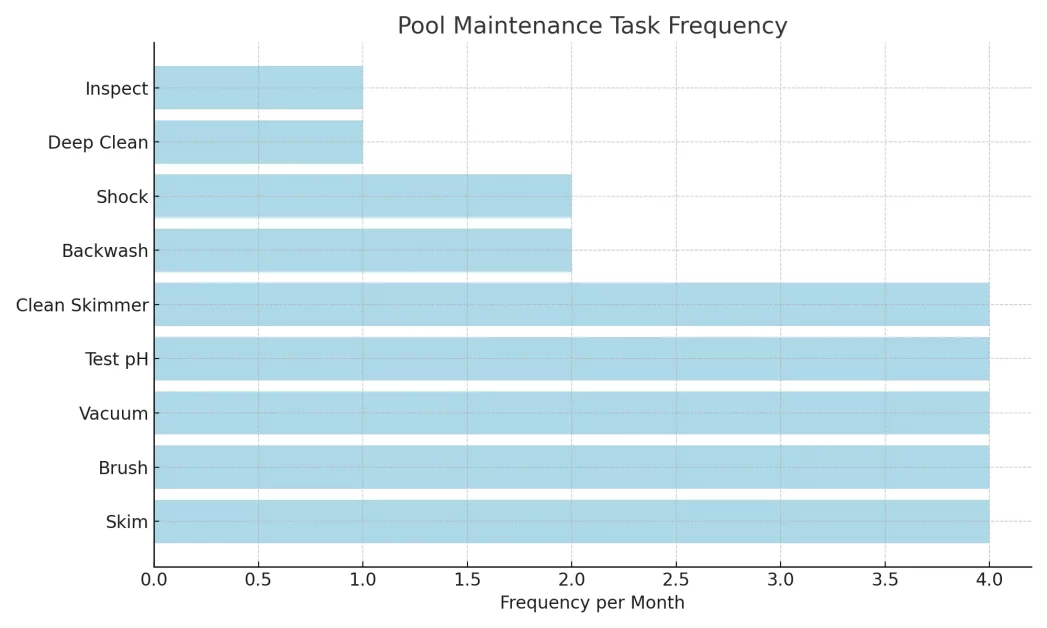
Key Insights:
- Tasks like Skim, Brush, Vacuum, Test pH, and Clean Skimmer have a frequency of 4 per month. This means these tasks should be performed weekly.
- Backwash, Shock, and Deep Clean have a frequency of 1-2 times per month. This indicates these tasks are done bi-weekly or monthly depending on pool usage.
- Inspection is suggested to be done once a month, which likely includes checking equipment and overall poor condition.
This chart simplifies your pool maintenance routine by visually showing how often each task should be completed.
How to Fix Cloudy Water in a Swimming Pool
Cloudy water in a pool can be frustrating, but it’s usually the result of a few common issues that can be addressed with proper steps.
By following these steps, you’ll have your pool back to clear and inviting in no time. Regular maintenance and monitoring will help prevent cloudy water from returning.
1. Check and Balance Pool Chemistry
Start by testing your water’s chemical levels. Cloudiness is often caused by an imbalance in the pH, alkalinity, or chlorine levels.
- pH Level: Should be between 7.2 and 7.6.
- Alkalinity: Should be between 80 and 120 ppm (parts per million).
- Chlorine: Maintain between 1-3 ppm for effective sanitization.
Adjust as needed using pH increasers/decreasers, alkalinity adjusters, and chlorine shock.
2. Shock the Pool
If the pool’s chlorine level is low, organic contaminants like algae, bacteria, and sweat may cause cloudiness. Shocking the pool with a high dose of chlorine kills these contaminants and clears the water.
- How to Shock:
- Add the shock treatment in the evening or at night.
- Make sure the pump is running to circulate the chlorine throughout the pool.
- Wait for chlorine levels to return to normal (1-3 ppm) before swimming.
3. Run the Pool Filter
Cloudy water can result from poor filtration. Make sure the filter is running properly and long enough to filter out particles from the water.
- Run Time: Aim to run your filter at least 8-12 hours per day, especially after heavy use or a storm.
- Clean the Filter: If the filter is clogged or dirty, it won’t work efficiently. Backwash or clean the filter according to its type (sand, cartridge, or DE).
4. Use a Pool Clarifier
Pool clarifiers can be added to the water to bind small particles together, making them easier to filter out. They work well to clear up mild cloudiness quickly.
- How to Use Clarifier: Follow the manufacturer’s instructions for dosage based on your pool size. After adding it, run the pump to circulate the water.
5. Vacuum the Pool
Debris and algae on the pool floor can contribute to cloudiness. Vacuuming the pool manually or using an automatic vacuum will help remove the particles that the skimmer basket or filter can’t catch.
6. Check Calcium Hardness
If your pool water has high calcium levels, it can cause cloudy water due to calcium scaling. Test the calcium hardness and adjust if needed.
- Ideal Calcium Levels: Between 200-400 ppm.
- Adjusting Levels: If the calcium hardness is too high, partially drain and refill the pool with fresh water.
7. Prevent Cloudy Water in the Future
- Regularly test and balance your water chemistry.
- Run your pump and filter daily.
- Skim the pool to remove debris.
- Clean the pool’s filter regularly.
- Shock the pool after heavy use or storms.
DIY Pool Maintenance Tips
What are some effective DIY tips for maintaining a clean and healthy pool?
- Test Water Regularly: Ensure the chemical balance is correct by testing the pH, chlorine, and alkalinity levels at least once a week.
- Skim and Brush: Use a skimmer net to remove debris from the surface and a brush to scrub the pool walls and floor regularly.
- Vacuum: Manually vacuum the pool or use an automatic cleaner to keep the bottom clean.
- Maintain Filter System: Clean and backwash your pool filter as needed to keep it functioning efficiently.
- Monitor Water Level: Keep the water level consistent to ensure proper circulation and filtration.
Check out Troubleshooting and Solutions for Mysterious Particles in Your Pool
How can I prevent algae growth in my pool?
- Maintain Chlorine Levels: Chlorine is essential for preventing algae; keep levels between 1-3 ppm.
- Shock Treatment: Perform a shock treatment weekly or bi-weekly to kill any potential algae spores.
- Use Algaecide: Apply algaecide regularly as a preventative measure.
- Circulate Water: Run the pump daily to keep the water moving and prevent algae from settling.
What are some cost-effective ways to maintain my pool?
- DIY Cleaning: Handle basic cleaning tasks yourself instead of hiring a service.
- Buy in Bulk: Purchase pool chemicals in bulk to save money in the long run.
- Energy-Efficient Equipment: Invest in energy-efficient pumps and heaters to reduce electricity costs.
- Pool Cover: Use a pool cover to reduce evaporation, keep debris out, and maintain temperature.
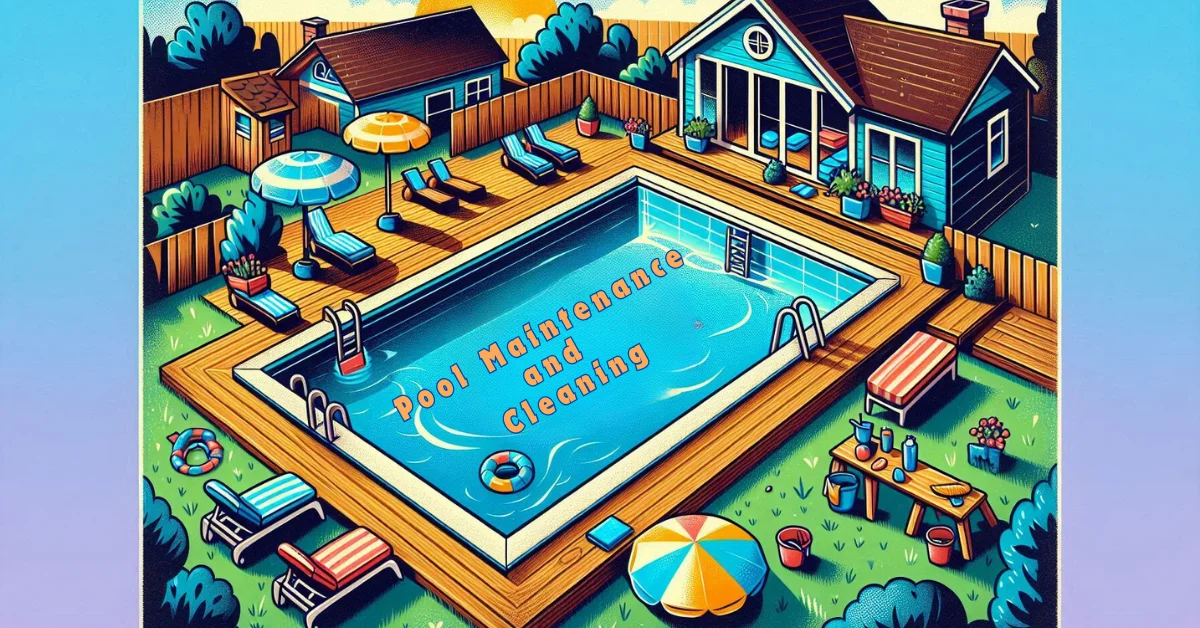
Check out Baking Soda in A Pool: Is It A Good Alternative To Chlorine
Does the cleaning frequency change with seasons or pool usage?
The frequency of cleaning can change with the seasons. During the summer months, when the pool is used more frequently, you may need to clean the pool more often. If the pool water temperature is over 73 °F (23 °C), it is recommended to scrub your swimming pool daily with a brush to inhibit bacteria and algae growth.
In contrast, during the winter months, when the pool is not in use, you may reduce the frequency of cleaning.
Usage Considerations: The frequency of cleaning also depends on how often the pool is used. If the pool is frequently used, it may require more frequent cleaning. Similarly, if many trees and plants around the pool shed leaves and other debris into the pool, more frequent cleaning may be necessary.
Pool Maintenance Cost: What to Expect
By being proactive with these strategies, you can enjoy your pool without breaking the bank! Whether it’s chemicals, equipment, or cleaning services, being prepared will save you from unexpected surprises.
Monthly and Annual Pool Maintenance Expenses
Here’s a general breakdown of typical pool maintenance costs:
- Chemicals:
- Chlorine: $20 – $50 per month, depending on pool size.
- pH Balancers and Other Chemicals: Around $10 – $30 per month.
- Total Annual Chemical Cost: Approximately $360 – $960.
- Equipment Maintenance:
- Filter Replacement: $100 – $200 annually, depending on the type of filter (sand, DE, cartridge).
- Pump Maintenance/Repair: $150 – $300 per year, depending on usage.
- Cleaning Services (Optional):
- Weekly Pool Service: Around $80 – $150 per month, depending on the size of the pool and the services required.
- Annual Cleaning Service Costs: Approximately $960 – $1,800.
How to Lower Pool Maintenance Costs
If you’re looking to save on pool maintenance without sacrificing water quality, here are a few strategies to consider:
- Time-Saving Tips:
- Invest in a robotic pool cleaner. While it’s a larger upfront cost ($500 – $1,500), it can significantly reduce the time and labor involved in manual cleaning and save on hiring services in the long term.
- Keep your pool covered when it’s not in use. This prevents debris from getting in and reduces evaporation, saving you time on cleaning and water replacement.
- Cost-Effective Chemical Use:
- Test the water regularly. By testing your pool’s chemistry at least twice a week, you can catch small imbalances before they become larger (and more expensive) problems.
- Use chemical stabilizers like cyanuric acid to help chlorine last longer, reducing how much you need to use over time.
- Keep an eye on the pH levels—proper balance reduces the need for frequent chemical adjustments and prevents damage to pool surfaces.
Pool Winterization and Opening
By properly closing and opening your pool, you can extend its life and make sure it’s always ready for a refreshing swim when the time comes.
Winterization protects your pool from damage caused by freezing temperatures, while proper opening techniques ensure the water is safe and ready to use when the weather warms up.
How to Close Your Pool for Winter
Preparing your pool for winter is a crucial step in protecting your investment. Here’s a guide to ensure you close it correctly:
Pool Cover Installation Tips
- Clean the Pool: Before covering your pool, ensure it’s thoroughly cleaned to prevent dirt and debris from causing stains or algae growth over the winter.
- Choose the Right Cover: Invest in a durable, weather-resistant pool cover. Consider using a safety cover to prevent debris from entering and to protect against accidental falls.
- Install the Cover Securely: Make sure the cover is tightly fitted to prevent it from sagging or blowing away in strong winds. Use water bags or clips to secure it around the edges.
Winterizing Your Pool Equipment
- Lower the Water Level: Reduce the water level below the skimmer and return lines to prevent freezing and cracking.
- Drain Equipment: Drain your pump, filter, heater, and any other pool equipment that could retain water and freeze during winter.
- Add Antifreeze: Pour pool-safe antifreeze into your plumbing lines to prevent ice from forming inside.
- Remove Accessories: Take out ladders, handrails, and other pool accessories to prevent them from getting damaged during the winter months.
How to Open Your Pool After Winter
When the weather warms up, it’s time to bring your pool back to life. Proper opening techniques ensure your pool is clean and safe for swimming.
Testing, Balancing, and Cleaning Techniques for Pool Opening
- Remove the Cover Carefully: Make sure to clean off any debris before removing the pool cover. Rinse and dry the cover thoroughly before storing it.
- Reinstall Equipment: Replace any accessories or equipment that was removed during winterization. Ensure all equipment is clean and functioning properly.
- Fill the Pool: Refill the water to the appropriate level, typically halfway up the skimmer.
- Test the Water: After the water is circulated for 24 hours, test your pool’s chemistry. You’ll want to check the pH, chlorine, alkalinity, and calcium hardness levels to ensure they’re balanced.
- Shock the Pool: If needed, give your pool a shock treatment to eliminate any contaminants that may have built up during the off-season.
- Clean Thoroughly: Vacuum the pool to remove any debris and brush the walls and floor to ensure a fresh start.
Explore More
Common Queries:
- How often should I test my pool water? Test your pool water at least once a week for sanitizer levels and pH balance. During peak swimming season, increase testing frequency.
- What is the ideal pH level for my pool? The ideal pH level for pool water is between 7.2 and 7.6 to ensure effective chlorine use and comfort for swimmers.
- Can I clean my pool less frequently if I use a pool cover? A pool cover can reduce debris and evaporation, but regular cleaning and chemical checks are still necessary.
- How do I remove algae from my pool? Brush the pool walls and floor, then apply an algaecide according to the manufacturer’s instructions.
- What should I do if my pool water becomes cloudy? Check and adjust the chemical balance, run the filter, and use a clarifier to clear the water if necessary.
- How long after adding chemicals can I swim? Wait at least 30 minutes to an hour after adding minor chemicals and 8-12 hours after shocking the pool before swimming.
- What’s the best way to maintain my pool’s filter? Clean or backwash your filter regularly, and replace the filter media as the manufacturer recommends.
- How can I prevent calcium buildup in my pool? Maintain balanced water chemistry, particularly pH and alkalinity, to prevent calcium deposits.
- What are the signs that my pool needs more chlorine? If you notice algae growth, a strong chlorine smell, or if test strips show low chlorine levels, it’s time to add more.
- How often should I shock my pool? Shock your pool once a week or bi-weekly, and more frequently if the pool is heavily used or after heavy rain.
- Can I use household bleach in my pool? While household bleach contains chlorine, it’s not formulated for pools and may affect water balance. Use pool-specific chlorine products.
- Why is my pool pump making noise? A noisy pump could indicate a clog, worn bearings, or a need for lubrication. Check for obstructions and consult a professional if necessary.
- How do I winterize my pool? Balance the water chemistry, lower the water level, clean and plug the pipes, add winterizing chemicals, and cover the pool securely.
- What’s the difference between stabilized and unstabilized chlorine? Stabilized chlorine contains cyanuric acid, which protects it from sunlight degradation, while unstabilized chlorine does not and is best for indoor pools or shock treatments.
- How can I save on pool maintenance costs? Perform regular DIY maintenance, buy chemicals in bulk, invest in energy-efficient equipment, and use a pool cover to reduce heating and cleaning costs.
- How often should I backwash filters?
- Backwash your pool filter when the pressure gauge shows a 10 psi increase from the normal starting level or once every 1-2 weeks, depending on pool usage.
- Any tips for balancing pool chemicals?
- Test your water at least twice a week, adjusting pH levels to stay between 7.2 and 7.6. Add chlorine as needed, shock the pool weekly, and use algaecide for prevention.
Statistics and News
Statistics:
- The global swimming pool construction services market will reach $275 billion by 2025.
- In 2020, the U.S. pool industry’s revenue was approximately $11 billion.
- The number of pools built in 2020 increased by 23% compared to 2019.
- The U.S. swimming pool industry employed over 50,000 people in 2020.
- Swimming pool sales in the U.S. rose by 54% in 2020.
- 85% of pool purchasers hired professionals for routine maintenance.
- The market size of the Pool Cleaning Services industry in the U.S. has grown by 1.7% per year on average between 2016 and 2021.
- The average pool owner spends between $3,000-$5,000 on chemicals and maintenance yearly.
- On average, a weekly pool cleaning service in the U.S. costs $125-$150 per month.
News:
- WYBOTICS has released the next-generation robotic pool cleaner, the WYBOT C1 PRO, which promises to make pool maintenance effortless, cost-effective, and enjoyable.
- A recent study shows that nearly three-quarters of Americans mistakenly assume clear pool water is clean and swim-safe.
- Entrepreneurs are diving into success by starting pool-cleaning businesses following the surge in demand for pool maintenance services.







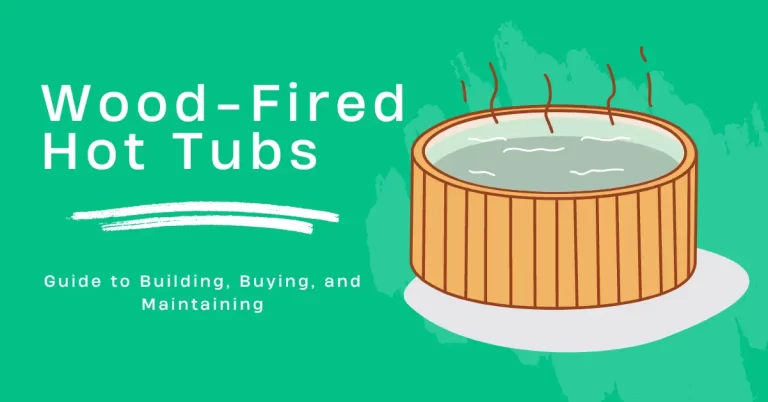

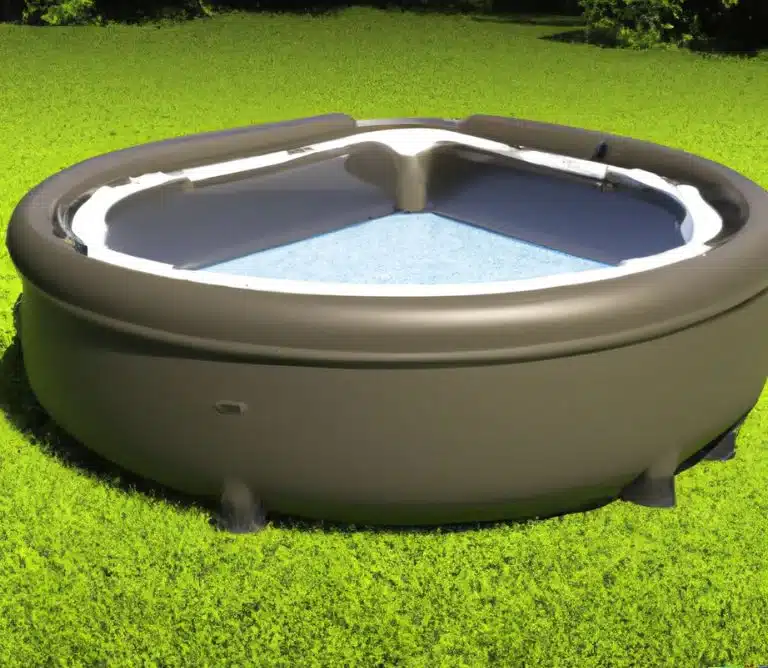
One Comment